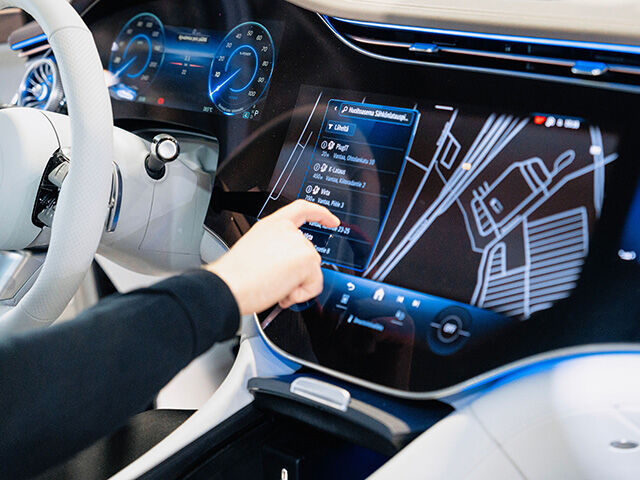

Can an electric car run out of battery unexpectedly on a winter road? And what should you remember when charging your car in freezing weather? Frans Junno and Timo Lehto, Product Managers at Veho, answer questions from electric car drivers.
"There is no such risk. All-electric Mercedes-Benz passenger cars have an easy-to-use navigation system that reliably assesses the battery charge level. The system can take into account a wide range of factors such as temperature, weather conditions, traffic conditions and driving style. The driver receives up-to-date information on the remaining operating distance and can guide the driver to the charging point in time. So there's no need to be stressed.
If the target is already close, but the range is limited, the driver can activate the so-called range maximisation function in the EQ menu under Range. This reduces certain comfort functions and increases the mileage.
In general, it is worth remembering that the operating range of a fully electric car is up to 20-50% shorter in winter frosts than in summer. The operating range and the smoothness of a journey can be significantly influenced by pre-heating the vehicle interior and battery with easy automatic functions available."
Read more: Electric driving in winter is hassle-free when you use the preheating correctly

It's always quicker to charge a battery when it's warm than when it's freezing cold. So when you arrive to destination, charge your car immediately. If there is no charging facility at your destination, visit the DC charging station immediately rather than, for example, the next morning. When you charge your car at a fast-charging station (a so-called DC charging point) in winter, DC charging can take much longer as the battery gets colder during the night.
You should only charge the battery to 100% only when necessary, for example before a long drive. In everyday life, an 80% charge level is usually good enough for daily driving. This is true in both winter and summer weather.
Charging in all weather conditions is made easier by the Mercedes me Charge service, with many charging operators available on a single contract. The price of electricity is the same regardless of the operator, and there is no need for drivers to conclude separate contracts or download apps at different charging stations. The service is available throughout Europe.

"The rolling resistance and drag of a wide tyre is naturally higher than that of a narrow tyre. The size of the tyre therefore affects the operating distance. In general, winter tyres increase energy consumption by about 5% compared to summer tyres of the same size.
The efficiency of the electric motor is high (90-96%), which means that the electric car uses almost all its energy to move. In this case, resistance such as slush on the road or tyre size, for example, has a greater percentage impact on driving performance than in an internal combustion engine car, which has an engine efficiency of only 25-30%. "
More tips on electric cars:
Driving an electric car on winter roads is hassle-free if you use the preheating correctly
Road trip by electric car - five tips for planning